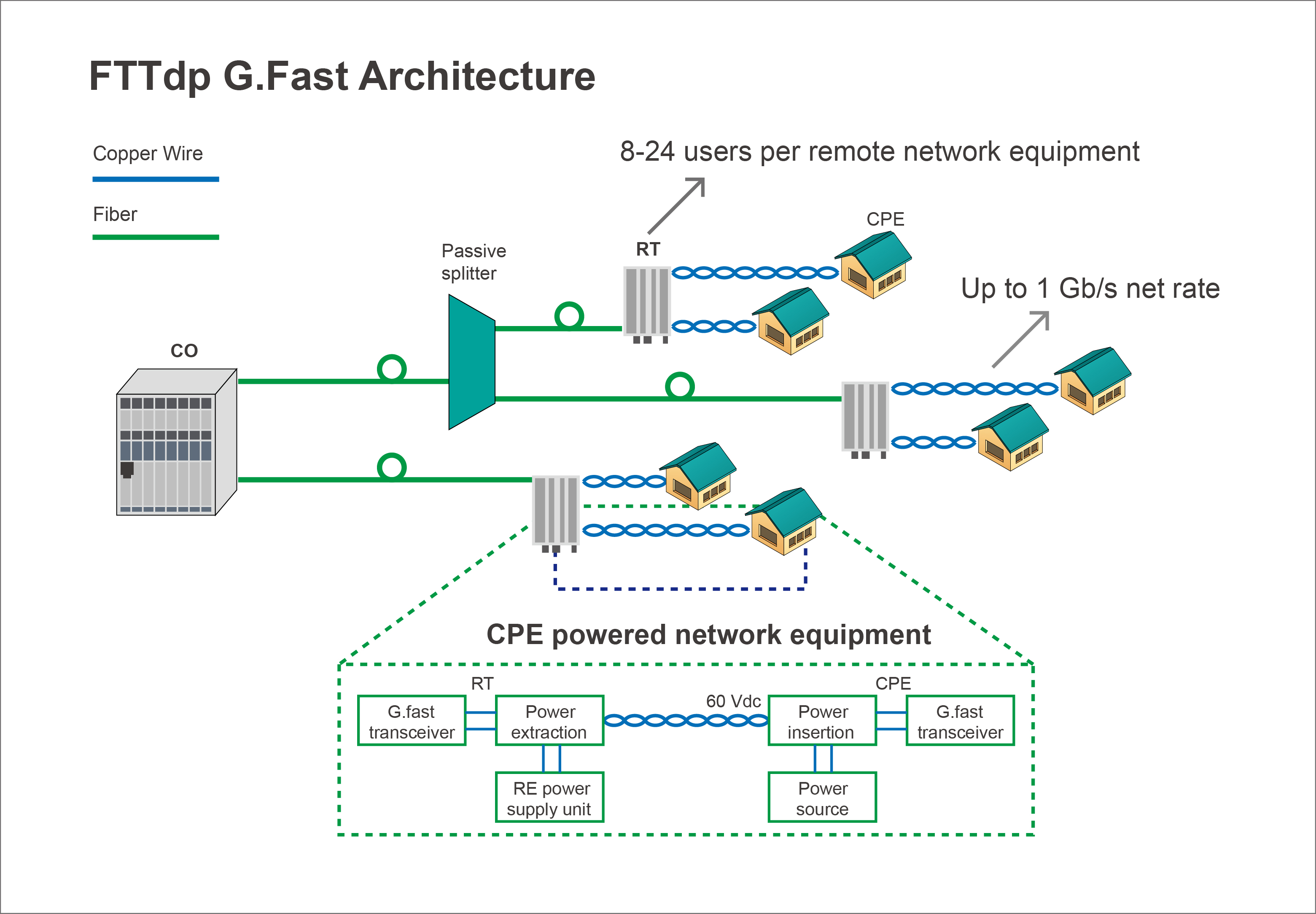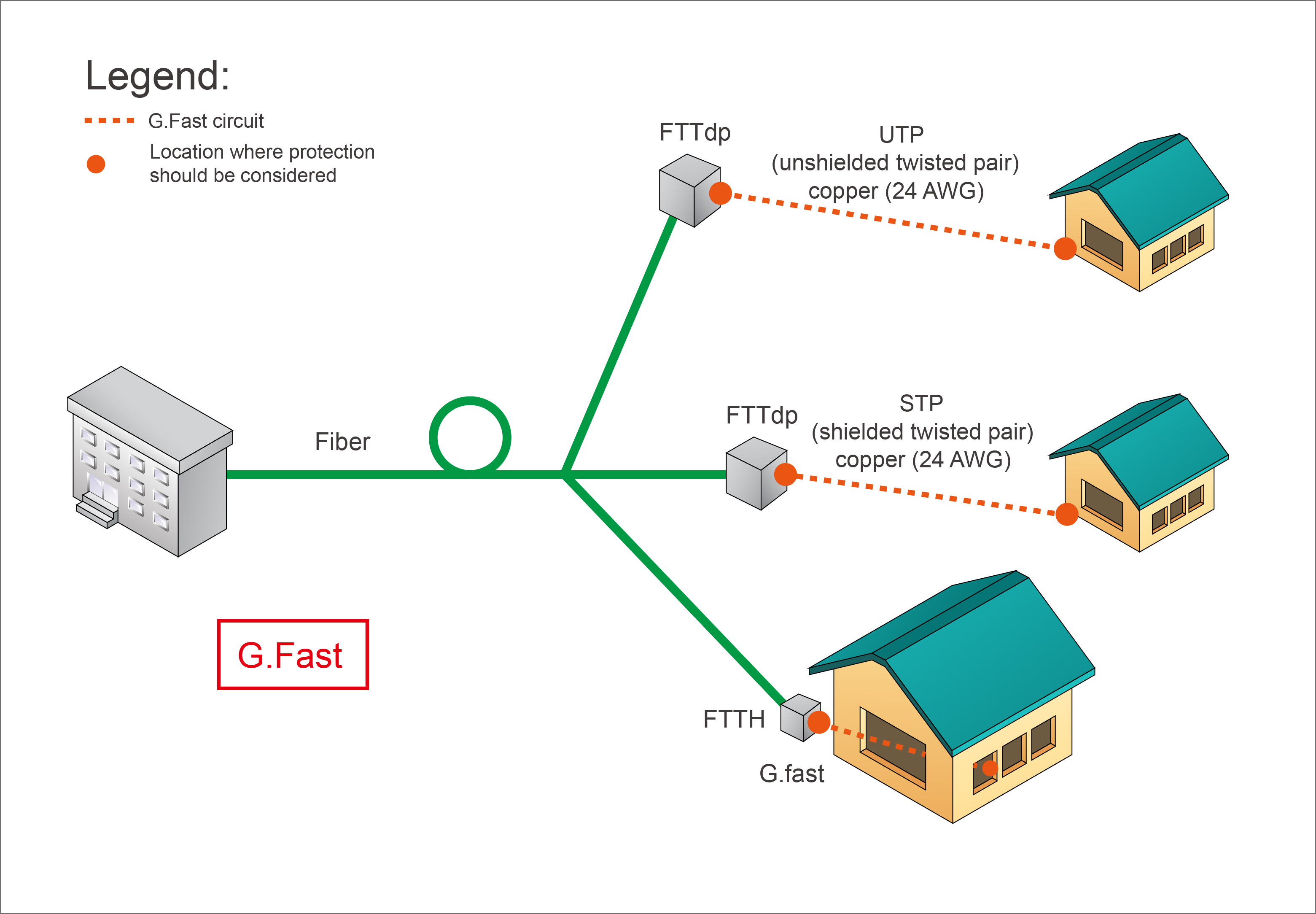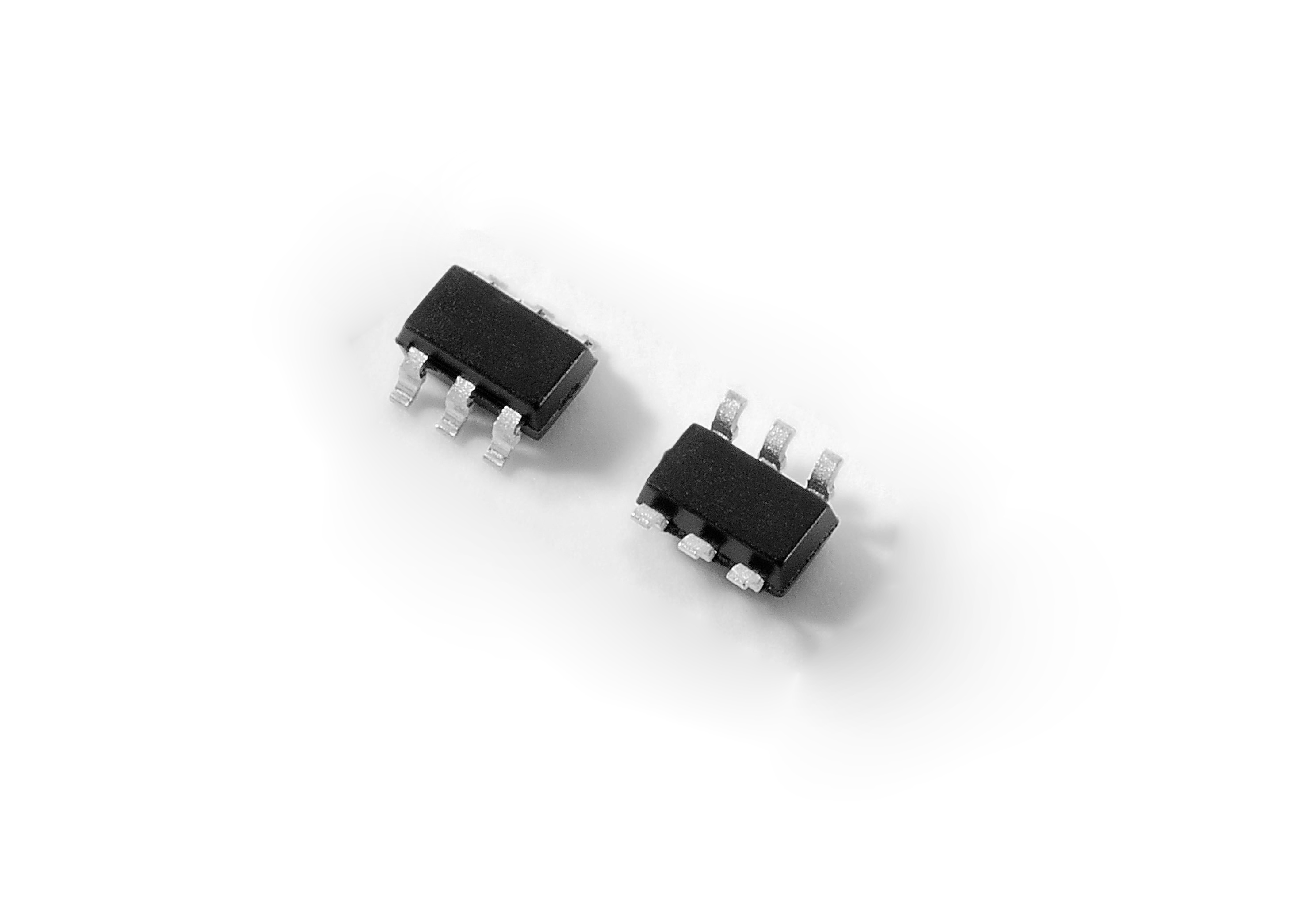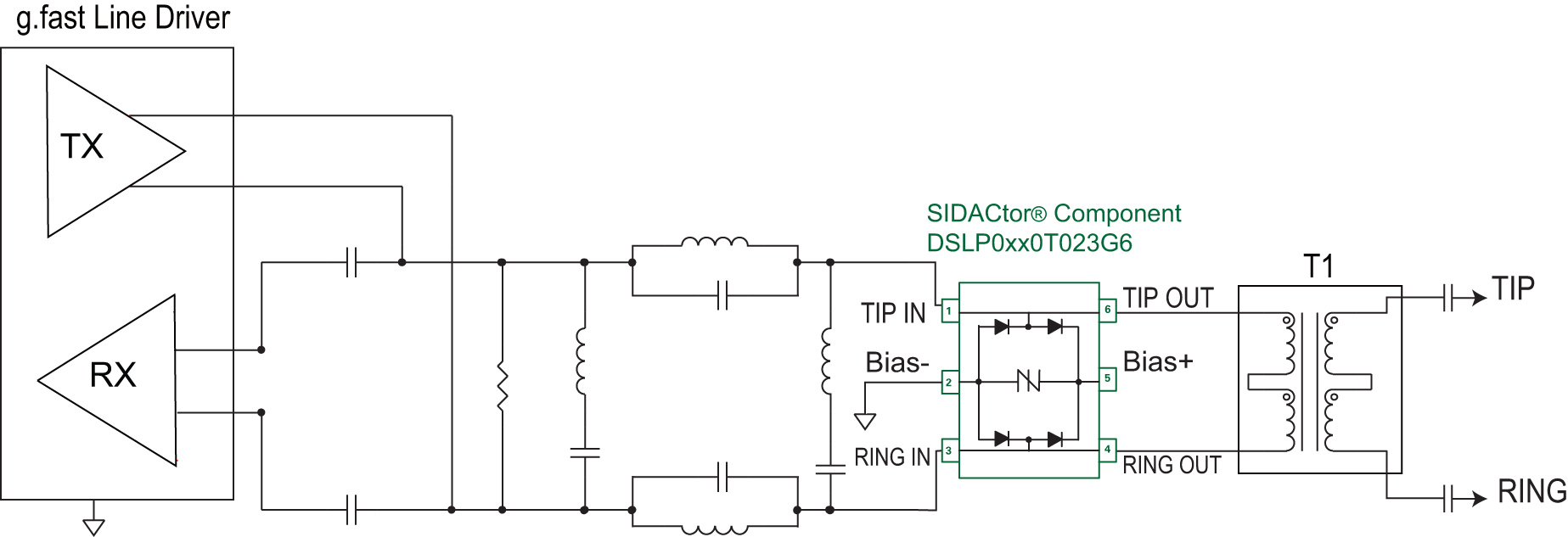Build an express lane to the cloud
Increasingly, personal and business information is being stored as digital information in the cloud, G.fast technology allows fast, reliable and secure access, writes Phillip Havens, principal engineer, Standards & Applications, Littelfuse
In order for telecomms providers to reach customers’ premises with fibre networks, they need to leverage the copper wiring they already have in place. That will require the use of G.fast technology, which allows customers to obtain fibre-like access speeds, as telecomms providers phase in their fibre deployments.

Figure 1: Fibre to the distribution point (FTTdp) access network
It is also complementary to FTTdp (fibre to the distribution point), multi-port FTTdp, FTTC (fibre to the cabinet, or kerb), and FTTH (fibre to the home) with the advantage of not restricting the available fibre bandwidth nearly as much as previous xDSL technologies. For example, while VDSL2 peaks at 100Mbit/s, reaching that speed requires bonding (i.e. the use of two twisted-wire pairs) and vectoring, to cancel out crosstalk. Similarly, ADSL2+ has a top speed of 10Mbit/s, the maximum for ADSL2 is 5Mbit/s, and ADSL is limited to 1Mbit/s. In contrast, G.fast technology has a targeted data rate of 1Gbit/s over 100m of single twisted-pair (24 AWG/0.5 mm) cable. Improvements to the technology offer the possibility of still faster data speeds. Research underway at Sckipio, the pioneer in G.fast chipset technology, has also begun to suggest that distances up to 500m may be possible while providing speeds of up to hundreds of Mbit/s.
Circuit protection
For high bandwidth lines like G.fast, the capacitance created by any circuit protection components placed on the line has the potential to degrade the signal, thus reducing its rate and reach (see figure 3). However, G.fast modems and circuitry in the node cannot be left unprotected from lightning-induced surges. Customer premises equipment (CPE) designers have three basic circuit protection options available, namely, gas discharge tubes (GDTs), transient voltage suppressor (TVS) silicon protection arrays (SPAs), and SIDACtor protection thryristors.
Protection choices
GDTs, TVS SPAs, and SIDACtor protection thyristors each have advantages and disadvantages for G.fast circuit protection applications. The advantages of GDTs include surge current ratings as high as 20kA and capacitance ratings as low as 1pF with a 0V bias. They are typically used for primary protection due to their high surge rating, but their low interference for high frequency components sometimes make them a possibility for high-speed data links. Significant disadvantages for G.fast applications, include a high initial voltage threshold (which means they might not activate at a sufficiently low threshold when a surge occurs above the normal operating voltage of the system). GDT performance characteristics can also change when installed in dark places and have a relatively large footprint. Another disadvantage is thermal accumulation issues during power fault events.

Figure 2: FTTdp G.fast architecture
TVS SPAs are clamping type components offer low voltage threshold turn on values. Due to their clamping characteristics, they dissipate higher power levels and thus must be physically larger to achieve similar surge ratings as the thyristor crowbarring components. The larger silicon package results in higher off-state capacitance values that could be incompatible with high bandwidth signaling.
A SIDACtor protection thyristor can be thought of as a thyristor component without a gate. When its peak off-state voltage (VDRM) is exceeded, it will clamp a transient voltage to within the device’s switching voltage (VS) rating. Once the current flowing through it exceeds its switching current, it will crowbar and simulate a short-circuit condition. When the flow current is less than its holding current (IH), it will reset and return to its high off-state impedance. The advantages of SIDACtor protection thyristors include a fast response time, stable electrical characteristics, long-term reliability, and low capacitance. As crowbar devices, they cannot be damaged by voltage.
Regional considerations
In the US, circuit protection for equipment that the telecomms companies install on the network (e.g. in the cabinet that houses the optical network termination (ONT) unit), must be compliant with network equipment building system (NEBS) design guidelines, which may require compliance with GR-1089 Issue 6, port type three surges, the most severe for this type of equipment. The port type may be designated 3a/5a, due to the short loops. Each provider will define specific lightning resistibility requirements.
 Figure 3: A neighborhood view of circuit protection for G.fast
Figure 3: A neighborhood view of circuit protection for G.fast
DSLP-biased series SIDACtor protection thyristors combine over-voltage protection with capacitive loading characteristics compatible with high-bandwidth telecomms protocols, such as G.fast. The EpiSCR silicon crowbar technology on which they are based provides a better surge capability than traditional clamping silicon technology, such as TVS SPAs, and reduces the possibility of field failures caused by AC power fault and multiple transient surges or lightning, without compromising signal integrity, particularly at high data rates. A space-saving SOT23-6 package with a flow-through layout reduces the impedance mismatching ‘stub-effect’ common in non-flow-through PCB trace connections.
The latest versions of SIDACtor protection thyristors (Figure 4) are designed to protect telecomms equipment to the high surge level requirements of GR-1089 functionally, as long as it is correctly located in the circuit between the transformer and the DSL driver. The transformer attenuates the surge. The SIDACtor component can also be placed on the line side of the transformer if there is sufficient impedance between it and the entry point (typically an RJ11 connector), such as the high pass filters that are implemented in these types of applications.
 Figure 4: DSLP-biased series SIDACtor protection thyristors
Figure 4: DSLP-biased series SIDACtor protection thyristors
The amplitude of G.fast signals is much lower than those of existing xDSL services, so the varying voltage across the SIDACtor protection thyristor component is also very low. The result is an imperceptible variation in capacitance. With the component in the tertiary position, rate and reach testing has shown an acceptable loss of less than 0.2dB.
The latest SIDACtor protection thyristor design generation offers circuit designers developing G.fast hardware a variety of advantages. Incorporated into the PCB layout, they can provide lightning surge protection for both G.fast modems at the customer premises and G.fast drivers in the ONT unit, where the optical fibre terminates and the signal is translated into an analogue signal. This component has been designed into the Sckipio G.fast line drive reference design (Figure 5).

Figure 5: The low amplitude of G.fast signals, illustrated using a Littelfuse DSLPxx0T023G6, SIDACtor protection thyristor component
This design is also useful for protecting telecomms equipment to the high surge level requirements of GR-1089 functionality. It can prevent signal degradation due to its initial low off-state capacitance (just 2.0pF max vs. 3.0 or 5.0pF max for other products on the market) and its extremely low variance in capacitance over voltage swings, so it does not interfere with the steady-state signals (variations in capacitance demodulate the DSL signal). Together, the low capacitance and low variation in capacitance allow for maximum rate and reach capabilities for the G.fast services.
The thyristor design offers various stand-off voltages, making it compatible with the G.fast power spectrum density limits, yet it can also be used in G.fast chipsets that are backward-compatible with VDSL2. In these cases, many of the line drivers will increase their output voltage range to meet the VDSL2 PSD limits if they fall back to a VDSL2 mode. The higher stand-off voltages are compatible with the higher steady-state voltages typically used for VDSL2.
The SOT-23-6 footprint helps lower PCB signal degradation because it offers a flow-through design that simplifies the board layout process, and allowing the circuit designer to keep the PCB traces parallel and eliminate the need for a stub connection, both conditions that could create an impedance mismatch on the line.
The design also provides a high surge rating (minimum 30A) to protect the G.fast modem when a lightning-induced surge races down or across the tip and ring pair. The crowbarring-type component will look like a short circuit that diverts the surge current away from the G.fast line driver, preventing damaged. The thyristor automatically resets once the surge event has passed, and the modem continues to run.











